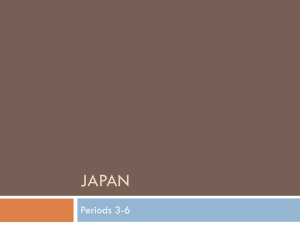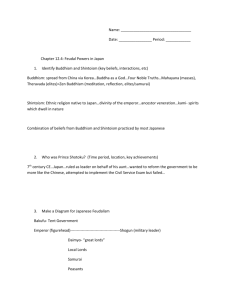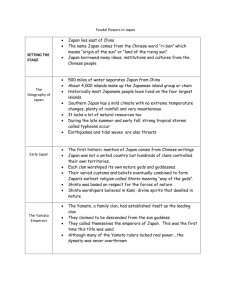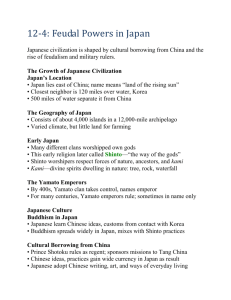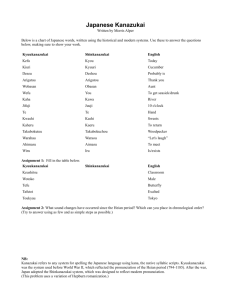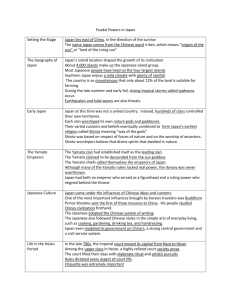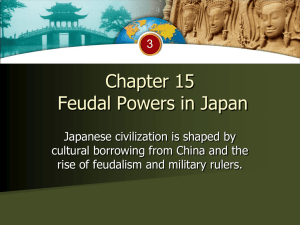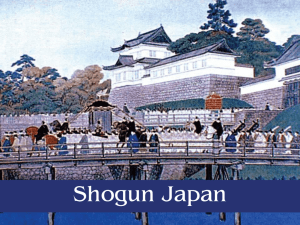Name: __________________________________ Date: ________________ Period: ____________ Chapter 12.4: Feudal Powers in Japan
advertisement
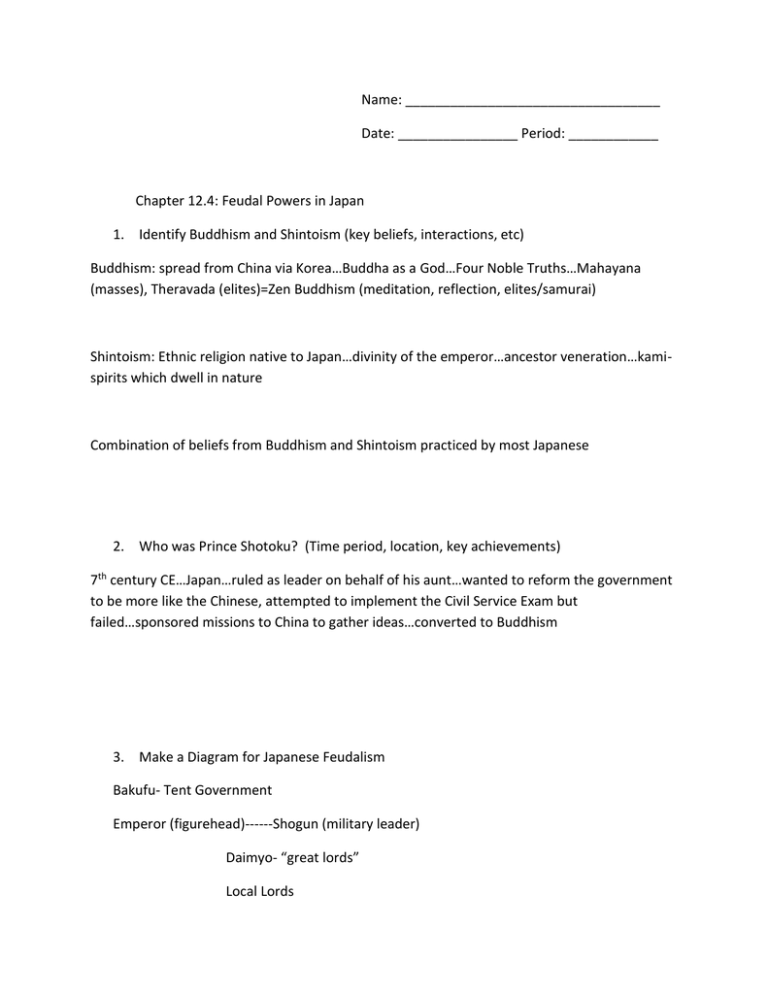
Name: __________________________________ Date: ________________ Period: ____________ Chapter 12.4: Feudal Powers in Japan 1. Identify Buddhism and Shintoism (key beliefs, interactions, etc) Buddhism: spread from China via Korea…Buddha as a God…Four Noble Truths…Mahayana (masses), Theravada (elites)=Zen Buddhism (meditation, reflection, elites/samurai) Shintoism: Ethnic religion native to Japan…divinity of the emperor…ancestor veneration…kamispirits which dwell in nature Combination of beliefs from Buddhism and Shintoism practiced by most Japanese 2. Who was Prince Shotoku? (Time period, location, key achievements) 7th century CE…Japan…ruled as leader on behalf of his aunt…wanted to reform the government to be more like the Chinese, attempted to implement the Civil Service Exam but failed…sponsored missions to China to gather ideas…converted to Buddhism 3. Make a Diagram for Japanese Feudalism Bakufu- Tent Government Emperor (figurehead)------Shogun (military leader) Daimyo- “great lords” Local Lords Samurai Peasants Chapter 12.4: Feudal Powers in Japan I. The Growth of Japanese Civilization Japan’s island location: shaped growth of civilization 120 miles of water between Japan and Korea…500 miles of water between Japan and China Sinification of Japan…relatively safe from invasion A. The Geography of Japan 4,000 islands make up the Japanese archipelago o Arc 1,200 miles long Most Japanese live on four largest islands: Hakkaido, Honshu, Shikoku, Kyushu Advantages: mild climate, plenty of rainfall Disadvantages: mountainous terrain…only 15% of land is arable…natural resources such as coal, oil, and iron in short supply…late summer and early fall- typhoons…earthquakes and tidal waves B. Early Japan Chinese writings of AD 300 mention Japan…at that time, Japan was not united…hundreds of clans controlled their own territories Each clan worshiped its own nature gods and goddesses Shintoism “way of the gods.” Ethnic religion native to Japan...spirits that dwell in nature (kami) Shinto had no complex rituals or philosophy…based on respect for the forces of nature and veneration of ancestors KAMI- divine spirits that dwelled in nature…struck by beautiful scene in nature- home of kami C. The Yamato Emperors 5th century: Yamato clan had established itself as the leading clan Yamato claimed to be descended from sun goddess Amaterasu By 7th century: Yamato chiefs called themselves emperors of Japan o Early emperors did not control the entire country o Japanese gradually accepted the idea of an emperor Japan had an emperor who reigned as a figurehead and a power behind the throne who actually ruled. o Dual structure II. The Japanese Adapt Chinese Ideas Around 500 Japanese began to have more contact with mainland Asia o Influenced by Chinese ideas and customs, which they learned about from the Koreans (Sinification) o 6th century- many Koreans migrated to Japan A. Buddhism in Japan One of the most important influences brought by Koreans to Japan was Buddhism Mid-700’s Japanese imperial court officially accepted Buddhism in Japan 8th and 9th century: Buddhist ideas and worship had spread through Japanese society Buddhism more complex than Shintoism o Blending of ideas Some Buddhist rituals became Shinto rituals, and some Shinto gods and goddesses were worshipped in Buddhist temples B. Cultural Borrowing from China Interest in Buddhism at the Japanese court led to enthusiasm for all things Chinese Prince Shotoku: converted to Buddhism…served as regent for his aunt, Empress Suiko 607: Prince Shotoku sent first of 3 missions to Tang China o Studied Chinese civilization firsthand o 600 scholars, painters, musicians, and monks traveled on each mission Japanese adopted the Chinese system of writing, which reached Japan through the Koreans Japanese artists painted landscapes in the Chinese manner Japanese followed Chinese styles in simple arts of everyday living: cooking, gardening, drinking tea, hairdressing For a time, Japan modeled its government on China’s o Prince Shotoku planned a strong central government like that of the Tang rulers o Tried to introduce the civil service exam…failed o Japan: noble birth remained the key to winning a powerful position…Japan continued to be a country where a few great families held power Japanese adapted Chinese ways to suit their own needs Eventually, Japanese imperial court severed ties with Tang empire…ended formal missions in the late 9th century III. Life in the Heian Period 794: imperial court moved the capital from Nara to Heian (modern Kyoto) Many of Japan’s noble families moved to Heian also Highly refined court society arose 794-1185: Heian Period Elaborate ritual and artistic pursuits at court Rules dictated every aspect of court life o Length of swords o Color of robes o Forms of address o Noble women: hair to ankles, blackened teeth, dyed clothing to match seasons Everyone at court expected to write poetry and paint o Court officials looked down upon the common people Accounts of Heian society from diaries, essays, and novels written by the women of court Lady Murasaki Shikibu: 11th century masterpiece: The Tale of Genji (account of life of a prince in the imperial court…long prose narrative…considered world’s first novel) Sei Shonagon: wrote vivid sketches of court life in her diary, called The Pillow Book IV. Feudalism Erodes Imperial Authority During the Heian period, Japan’s central government was relatively strong Soon challenged by great landowners and clan chiefs, who acted more and more as independent local rulers A. Decline of Central Power For most of the Heian period, rich Fujiwara family held the real power in Japan o Held many influential posts o Middle of 11th century: power of the central government and the Fujiwaras began to slip o Court families grew more interested in luxury and artistic pursuits than in governing Large landowners living away from capital set up private armies o Countryside became lawless and dangerous o Armed soldiers on horseback preyed on farmers and travelers, pirates took control of the seas o For safety, farmers and small landowners traded parts of their land to strong warlords in exchange for protection Lords gained more power Feudal system of localized rule, like ancient China and medieval Europe B. Samurai Warriors Bodyguard of loyal warriors to lords called Samurai (“one who serves”) Samurai lived according to code of Bushido (“way of the warrior”) Samurai was expected to show reckless courage, reverence for the gods, fairness, and generosity toward those weaker than himself Dying an honorable death, was judged more important than living a long life Japanese Samurai Lived by a code of honor called Bushido, which values bravery and loyalty to their lord above all else. Will commit ritual suicide rather than face defeat or dishonor (seppuku) Fight for lord in exchange for an allowance Expect women to live up to same values of honor and courage Enter into battle with iron and leather armor, swords, and bows and arrows European Knights Live by code of honor called chivalry, which values bravery and loyalty to heavenly God, earthly lord, and chosen lady. Code also demands that knights show humility Fight for lord in exchange for land Regard women as weak creatures to be idolized and defended Enter into battle with chain mail or plate armor, broadsword, and lance Lady Tomoe Gozen, famous female warrior of the 1180’s The Zen Way: Zen School of Buddhism: popular among the samurai class…emphasized spirituality through self-discipline and meditation appealed to warriors (elite) C. The Kamakura Shogunate Late 1100’s, Japan’s two most powerful clans fought for power. 30 years of war, Minamoto family emerged victorious 1192: emperor gave Minamoto leader named Yoritomo the title of SHOGUN, “supreme general of the emperor’s army.” Shogun had the powers of a military dictator o Officials, judges, taxes, armies, roads were under his authority Emperor still reigned from Kyoto, but the real center of power was the shogun’s military headquarters at Kamakura 1200’s Kamakura Shogunate Shoguns through 1868 (Meiji Restoration) Shoguns: local lords held great power o Loyal local lords received free land o Shoguns also assigned a military governor to each province o Governors called Daimyo “great lords”, were responsible for maintaining peace and order Kamakura shoguns turned back the two naval invasions sent by the Mongols in 1274 and 1281 o But Japanese victory over the Mongols drained Japan’s treasury o Loyal samurai were bitter when the government refused to pay them o Samurai attached themselves more closely to local lords o Fighting between lords
